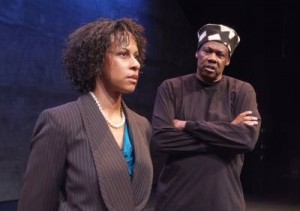
Playwright Thomas Gibbons completes his trilogy about black/white relations in the United States with A House With No Walls, the latest production of the Robey Theatre Company. The Robey, which was named after the great African American actor/singer/civil rights pioneer Paul Robeson, dedicates itself to producing plays about the African American experience. A House With No Walls fulfills the Robey’s mission with an engrossing drama which spans over 200 years and features black and white characters with a wide range of political points of view. It is likely that virtually everyone in the audience will identify with at least one of the people on stage. That Thomas Gibbons happens to be white is merely a footnote, so authentic and well-written are his characters.
The fact-based A House With No Walls takes place Philadelphia several years ago, as the Liberty Bell Center was in the process of being built on site of the U.S.’s first presidential mansion. Black activists were outraged that this center was to stand on the very ground where George Washington’s slaves were quartered, including the enslaved Oney Judge, Martha Washington’s personal servant.
Gibbons’ fictionalized version of these events centers around Cadence Lane, a beautiful, charming, and highly intelligent young black woman of the new millennium. Cadence finds herself at odds with Salif Camara, the older (and old school) black activist who is demanding to have a reconstruction erected of the tiny shack which housed Washington’s slaves when not at Mount Vernon…smack dab in the middle of the center. Cadence is the anomaly known as an African American Conservative, and as such believes that Salif’s demands would only serve to maintain African Americans’ status as “perpetual victims.” Not surprisingly, Cadence is showered with Oreo cookies whenever she speaks on a college campus.
Meanwhile, something strange is happening to Cadence. She is beginning to feel a connection with Oney Judge, and in fact Oney and her brother Austin are major characters in A House With No Walls, on stage even when the action is unfolding in the present.
Cadence also finds herself attracted once more by a former boyfriend, Allen Rosen, a Jewish liberal who is working with white Republican Steven Gardner in an effort to get the center completed on time, making Cadence and Allen the oddest couple of politically opposite bedfellows since Mary Matalin and James Carville.
The characters Gibbons creates here are more than just political stereotypes. Cadence’s father is a life long Democrat, who wouldn’t speak to his daughter for a month after she switched from Democrat to Independent, and in fact she still hasn’t registered as a Republican for fear of the consequences to her relationship with him. Salif feels that Cadence is committing the unforgivable sin of “letting white people off the hook,” but when he accuses her of being the “house Negro,” she quickly comes back with “Get in line!”
As all of this is happening in the present, back in 1797 a Quaker abolitionist named Tobias Humphreys is trying to convince Oney to escape, something which Oney refuses to even consider until (in a very powerful scene) she learns that even as President, George Washington has no intention of setting his slaves free. (We learn earlier that Washington made sure that his slaves returned to Mt. Vernon every six months, because if they stayed in Philadelphia longer than six months at a time, they would automatically have become free men and women.)
The play’s title comes from Oney’s desire to live in “a house with no walls,” for even though the slave quarters do indeed have walls, they can be entered at any time, for any purpose, by her white masters.
One of the things that Gibbons’ play does best is make slavery real, and not just an abstract concept. We see Oney’s earnest attempts to learn to read, and to teach Austin, a reminder that slaves were forbidden this knowledge. We see Oney’s vain hope that “massa” will do the right thing and make her dream come true, and Austin’s dream of getting on a ship and starting a new life on the ocean.
Director Ben Guillory, who is also the Robey’s Producing Artistic Director, does fine work here, and has assembled a talented cast, headed by Hugh Dane as Salif. Dane has the same imposing yet dignified quality that marks the performances of Morgan Freeman and Danny Glover, bringing fire and passion to the role. Toyin Moses gives a particularly moving performance as Oney, and Maurice McRae is equally good as her brother. Darin Dahms is a sympathetic Allen, and though not exactly a leading man type, does believable work as Cadence’s love interest. Dahms also doubles convincingly as Tobias, whom Allen had once written a paper about. Jonathan Palmer plays three roles, primarily that of George Washington, and he is very good in them all. Finally, in the central female role, Kellie Roberts is so good as Cadence, so classy, articulate, and even sympathetic as the “villain” of the piece that it was jarring to hear her stumble over many lines in Sunday’s performance.
Gibbons’ previous play, Permanent Record, went from the 99-seat Greenway Court Theatre to the Kirk Douglas. (The assistant director is Dwain Perry, who directed “Permanent Collection” at the Kirk Douglas.) A House With No Walls is playing at downtown’s The “NEW” LATC (as the Los Angeles Theatre Center is now known). With two-thirds of Theatre 2’s seats roped off, the play is being produced under the 99-seat plan, but it benefits greatly from the large-theatre scale stage.
Victoria Bellocq’s set resembles an imposing erector set-like framework of the under construction center. Jeremy Pivnick’s very effective lighting design aids in transporting the audience from the present day back to 1797. Set and lighting design meld in the lit from above center-stage square which represents the slave quarters, inside of which Oney’s scenes are played, and which remains lit throughout the production, a reminder that the construction site is in fact “on sacred ground.” (The one design misstep is the use of a small round table for one scene between Cadence and Allen, confusing because the scene apparently takes place in a private apartment and is blocked as such, yet the table suggests a cocktail lounge.)
Naila Aladdin Sanders’ excellent costume design spans centuries, from Oney and Austin’s slave garb to Cadence’s elegant classy modern wardrobe. Eric Butler’s sound design uses music and sounds to accompany and enhance the play’s various scenes and moods.
As both political drama and history lesson, A House With No Walls is well worth seeing.
THE NEW LATC, 514 S. Spring St. Theater 2, Los Angeles.
–Steven Stanley
May 11, 2008
Photos: Ed Krieger




 Since 2007, Steven Stanley's StageSceneLA.com has spotlighted the best in Southern California theater via reviews, interviews, and its annual StageSceneLA Scenies.
Since 2007, Steven Stanley's StageSceneLA.com has spotlighted the best in Southern California theater via reviews, interviews, and its annual StageSceneLA Scenies.







 COPYRIGHT 2024 STEVEN STANLEY :: DESIGN BY
COPYRIGHT 2024 STEVEN STANLEY :: DESIGN BY